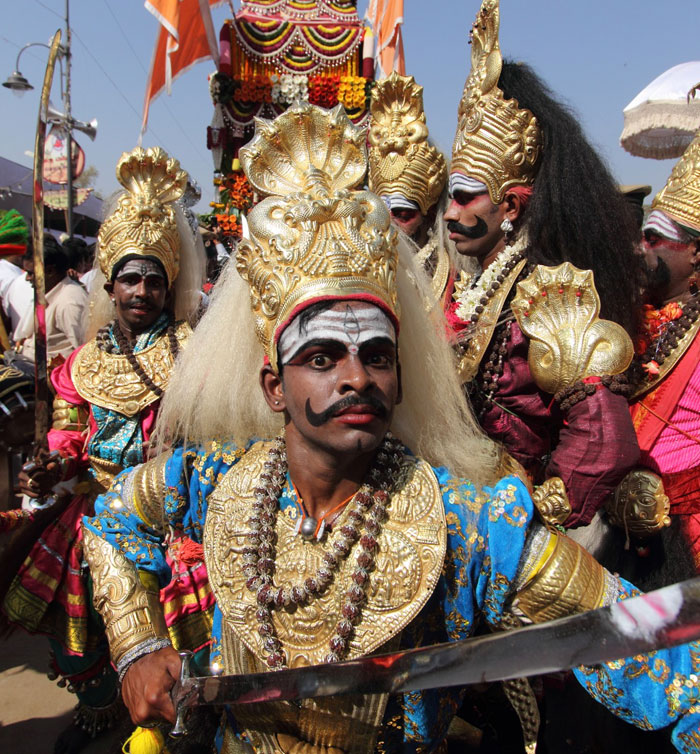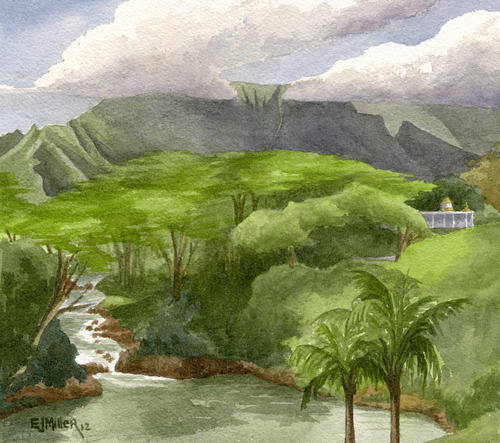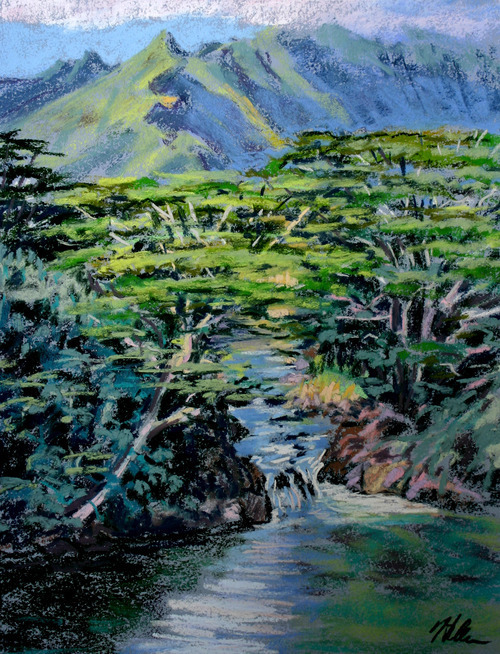Suttur Jathra Up Close

Some photos of the Suttur festival taken by professionals are beginning to arrive. A close-up of one of the virabhairavas.
Monastery Twitter Updates for 2012-01-29
- Here it is: your Kauai Aadheenam mushroom of the day http://t.co/A9azKG1a #
Powered by Twitter Tools
Swami Iswarananda of Chinmaya Mission Visits Aadheenam
Swami Ishwarananda Ji of the Chinmaya Mission in Los Angeles made his second visit to the Aadheenam today. He first visited ten years ago, and he barely missed meeting Gurudeva at that time. Accompanied by Sri Lankan devotees from Southern California, Swamiji told us that he came to Kauai this weekend solely to visit the monastery.
The group of thirteen attended the morning Siva puja, toured Iraivan Temple, met with Bodhinatha and met with some of the swamis of the Ganapati Kulam. The monks also served him and his entourage lunch.
Bodhinatha has always praised the good work of the Chinmaya Mission. Swami Ishwarananda is an excellent teacher and speaker, one of few that Chinmaya Mission has stationed permanently in the US. He and Bodhinatha met in November 2008 during a visit to Anaheim. Since then, Swami has moved the center to Tustin, just a few miles away, to accommodate a larger student body. Every Sunday they have 800 children and 400 adults attend their satsang and classes.
Kitchen at Suttur Mutt
The kitchen at Suttur Math (a small corner of it)
There are dozens of these vats!
Monastery Twitter Updates for 2012-01-28
- Manjari Sharma's Elaborate Photos: Hindu Mythology and Iconography - http://t.co/KZfRPX9I http://t.co/0lt76yI3 #
Powered by Twitter Tools
Today's Pilgrims Meet Bodhinatha
Rudiren Pillay will be departing for his home in South Africa tomorrow. We all want to thank him for his great attitude and spirit of service. He returns renewed with his mantra diksha. At lunch today he gave testimony on how inspired he was to to live among a group of people who are always happy.
One of the monks told him he thought it was a waste of time being unhappy. Since everyone is running around trying to do something to make themselves happy, they would save a lot of time and effort if they would just BE happy.
Durvan is here from Arizona. His home is in Malaysia and he's here working for Intel for the last three months for work. His family met our late Gurudeva years ago. He's looked forward for many years to finally visit Kauai Aadheenam for the first time. Durvan and his family in Malaysia have subscribed to Hinduism Today magazine for many years now.
Prasanna and Maya from Vancouver lived in India for 19 years where he did astrology at Ammachi Ashram. They had a long talk with Bodhinatha.
Visit to Shakti Amma's Sripuram, Vellore, India
Kauai monks and TAKA correspondents reporting from Sakthi Amma's Sripuram, Vellore, India.
Shakti, God Siva's energy, is evident at Sripuram. Shakti herself is here, in love of people, in the vibration of the pulsating murtis at beautiful temples, in the founder herself, Sakthi Amma.
Late last night we had a profound and at the same time leisurely meeting with Amma, a round-faced Tamil who is, in the eyes of thousands, Goddess Narayani Herself -- hence the feminine pronoun when referring to this man, focusing on her inner nature, not his external form. (You can read more in the article about Sripuram here).
Sakthi Amma felt like an old dear friend, a mature traveler on the spiritual path, with whom we could talk about things that are dear to monks like us. Many subjects came and went; we barely noticed time passing. Then Amma asked us if we perform go puja -- worship of our cows. We do not, we said. For the next ten minutes, Amma, visibly excited and thrilled, explained why we should, in a mystical way we had never cognized or imagined.
Cows, Amma said, in most situations are nothing but milk-giving gentle beasts. The latent power of a cow, however, is to offer not only milk but shakti, proving an energy of abundance, success and prosperity. Amma intimated that, at a monastery or spiritual institution, invoking that power was specially important, generating riches and the energy for all of the many different projects. Coming from a person who clad her temple in solid gold, I do not doubt this advice for a second.
On a different level, Gurudeva offered similar advice, saying that only when a wife is treated like a goddess, loved as the queen of the home, does she abundantly flow out her shakti to her husband, making him confident, successful and powerful.
On the next day, under Amma's orders, we went to see a go puja. At Sripuram, things happen in what they call "Amma time," a fluid state in which any appointment is fixed until she changes it, which she does all the time according to her own intuition. It is not a chaotic system, but rather quite fluid. And so it was that our 10:30am appointment with the cow became a 7:30am meeting, because Amma gracefully remembered we preferred to leave early for the long drive to Bangalore.
At the appointed time, there was Mahalakshmi, Amma's chosen cow, the only one to receive the daily honor. She was chosen for her beauty, her round horns, her friendliness and the ability to be motionless during the puja. Mahalakshmi stood in front of the small Narayani Temple, surrounded by three priests. The sound of drums, tavlas and nadaswaras electrified the air, giving it the feel of a festival. At the same time that the go puja was happening, priests worshiped Goddess Narayani in Her sanctum.
Mahalakshmi is a remarkable creature, soft in manners and demeanor. She stands quiet if not still, gently moving her head and legs once in a while, eyes-half closed in bovine contemplation. She does not ask for food, or demand attention, or walk away. We watch as priests gently paint her with freshly ground sandalwood paste and kumkum, anointing her horns in yellow paste and sandalwood oil. Mahalakshmi is the most nonchalant cow we have ever seen, and according to Amma, she has always been like that, an unperturbed divine bovine from her first day in the office of being venerated as a vessel for the Goddess' abundance. Music blasts, huge drums roll, bells deafen us; but Mahalakshmi was unperturbed.
After the decorations, the three priests put a beautiful cloth on her colorful back and offer her flowers, singing mantras in loud Sanskrit. Mahalakshi, well-behaved, does not try to eat the flowers, or the cloth. I am not sure we were following the etiquette as perfectly as she.
Sadasivanathaswami waved the arati in front of the serene cow, followed by a group of women who, their many hands holding the tray simultaneously, also venerated the tranquil boon-giver. We then circumambulated her three times, as if doing pradakshina around a temple. Oh, Hinduism, in which everything is sacred, in which God can be in any and all things.
Mahalakshi then ate a large amount of sweets, offered atop a banana leaf.
As soon as the puja ended, astounded by the simple charm of the experience, we were taken to the main shrine of the temple, where puja to Narayani was at its last stages. To Her right is Lord Ganesha and to Her left Subramanian, just like at Kadavul. The shakti that She emanates is full, loving, round and embracing, nothing like the sharp, piercing energy we feel at most Devi temples. We stay for the final arati, admiring the masterful craftsmanship of the sanctum wooden door, the beautiful adornments in gold; but most of all we bask in Her love and power.
That was our last moment of adoration at Sripuram. Soon, we were on the road towards Bangalore. But we brought Shakti with us, no doubt.
Monks Meet Suresh Muttukulam in Bengaluru
After finishing our publishing sessions in New Delhi, Sadhaka Satyanatha and I are off to the airport for the return flight to Bengaluru. It's hard to get used to the new airports in India. We are accustomed to a dark, third-world experience, but here and in Bengaluru things have changed. Airports are now full of art and sculpture, the the two elephants who chased us into the security lines. Moments later we are enthralled by a life-size sculpture depicting Surya Namaskar, twelve bronzes in the poses, on a spiriling platform
Inside, we are suddenly standing on two acres of new carpet in a massive space that could hold 10,000 passengers (and would have in days gone by). But this morning we are the only ones walking here. Such a feeling of abundant spaciousness. I get out my iPhone to capture the unlikely moment, but the drama is thwarted when a couple of fellow travelers turn the corner. We take the shot anyway.
In Bengaluru, we are joined by our Kerala artist, Suresh Muttukulam, who has taken a train from his home to be with us. I have brought him a Kauai Rudraksha Mala, our new favorite thing to share, and place itaround his neck. Suresh is working on the nine paintings that will ultimately be installed on the ceiling of the Swayambhu Mandapam. In the slideshow we share one of the completed works (they are four feet square!). Suresh is working late into the night, trying to finish in time for Bodhinatha's February event in Kerala. He also wants to finish because he has recently receive word of a commission for an 80-foot long and 10-fooot high mural for the new Mumbai Airport. It's so big, he will need assistants with the work.
Suresh has brought a gift too. It's a small bronze Ganesha holding a Sivalingam. What's special about this one is that Suresh has hand-painted it. It's delightful. He informs us that he is almost finished with the eighth wokl He speaks enthusiastically about an inspiration he has to do a Prodosha Siva, then pulls out a notepad and quickly suggests how it might look.
Jiva and Thurai join us for dinner, and soon Senthil and wife Nisha come. Wonderful day. Tomorrow we are off early to Vellore, a four hour ride that will take us to the Golden Temple of Shakt Amma. Aum Nama Sivaya
Paintings of the Monastery's Mountain View

A couple days ago two local artists visited Kauai's Hindu Monastery to paint our beautiful view of Mount Waialeale and the Wailua River.
Here is a watercolor by Emily Miller.

This piece by Helen Turner, focusing on the Nani Ka'ua pond and albizia forest on the Wailua River, is done in pastels.
Plein air art, that which is done out in nature, is a bit of an extreme sport, they say. Painting a live view is a race against time and light!
Both artists are considering studio paintings of this, one of the most magnificent views on Kauai, based on photos we have provided. Stay tuned!
Sadasivanathaswami and Sadhaka Satyanatha in New Delhi
The tone of our journey changes as Sadhaka Satyanatha and I fly up to New Delhi for a day of special meetings with our several publishers. (Note: this report is being typed in the back of a car hurling toward Vellore on an Indian road, this being an appeal for typing anomalies amnesty) The morning is dedicated to Hinduism Today's India Edition team, seen here in a special BPT (blurred photography technology) format designed to create a home-spun sensibility.
The Hawaii team and the Indian team spent hours working out details of the India Edition, which they propose to inaugurate on April 13th, New Year Day. Rajiv Malik, our dapper senior India Correspondent joins in the discussions. We have brought a proposed edition, complete with stories, for their consideration and go through the various articles with them. Not all members of the team could be present, but much progress was made nonetheless. Fourteen months ago this team called Bodhinatha and myself to meet, sharing that they wanted to publish Hinduism Today in India after reading it since 1993. Their appeal went something like this: "Satguru, Hindus of India were once full of cooperation and goodwill toward one another. Now, times have changed and there is conflict and competition between all the groups, all the ashrams and gurus. Only in Hinduism Today do we find an expression of the original heart of the Hindu, a heart of fellowship and support of one another. We need that here. I can tell you that all of us believe that the future of our religion in India may well depend on Hinduism Today. "Rajiv was with us the whole day, looking after details, coordinating. After two hours, we adjourn for lunch, continuing the conversations that will guide the magazine's direction in India. At Bodhinatha's request, I asked each one what future articles they would like the Hawaii team to develop, articles that Indian readers would like to read.
They respond enthusiastically, clearly happy to be involved in the development of content. They know the work ahead for them is massive and challenging. They have to assemble teams of writers and editors, production experts, marketing and advertising specialists and more. But they also know they have a competent team in Hawaii at the ready, there to help.
They suggest we do feature stories on Hinduism in Cambodia, on the wonders of Madurai Meenakshi Temple, plus one that interviews 20 people on the question: How I Became a (good) Hindu.
One of the team members, Ashok Kapoor, is at the UN on this day. But he will visit Kauai Aadheenam in early February on his way back to India.
We summarize the next steps each must take, and say goodbye. Next we meet with Shakti Malick, owner of Abhinav Publications. They are the publishers of our Weaver's Wisdom multi-language edition in India. He brings news of the progress of his next work with us, a full-color edition of "What Is Hinduism?" which is on the press and will be delivered by March. He wants to publish "The Guru Chronicles" (they all do!) and we hand him a copy for his scrutiny. Next an animated 90 minutes with the head of India's most prestigious Indology publishers, Motilal Banarsidass, over 110 years old. Rajeev Jain brings two of his main editors with him and clearly they have spent hours to prepare their long agenda. We tackle them one by one. Rajeev pulls out two finished books, the ink still tacky. He is thrilled to show us Loving Ganesha. MLBD printed the first edition 3 years ago, and sold out. In recent months our team on Kauai gave updated PDF files and he presents the result. He also hands me "Dancing with Siva," the Indian edition. It's in black and white, but that was necessary due to costs. He informs us that "Living with Siva" has gone to the printer and will be ready in March, and then "Merging with Siva" by the end of the year. It's a great day, to see Gurudeva's written legacy move into the Hindu mind in the land where it all began. We are reminded of all the effort Gurudeva put into the trilogy from 1995 to 2001. He drove himself and his team every day, without fail, to write these spiritual masterpieces. Then, on his fasting bed, we brought him the final one, Living with Siva. He held it in his hands, smiled softly as if to say, "We did it. It is complete. "
The next morning Sadhaka and I are off to the airport for the flight back to Bengaluru, and now as said above are heading into Tamil Nadu to visit Sakti Amma at her Golden Temple. Jai Gurudeva!
From Our Gurus' Teachings
Archives are now available through 2001. Light colored days have no posts. 1998-2001 coming later.
